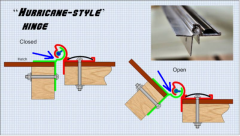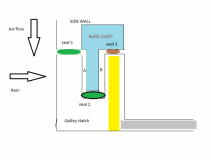Your design makes it really difficult. It is like upside down flashing. You have a design that collects water. To a large extent, this is why making your own door is difficult. Doing a TD side door must address this. Typically, the doors have small opening ( 1/8 to 1/4 ) and are flush when closed.

No matter where the seals are, water can be trapped above them. Another improvement might suggest using the green location and make sure water can flow away from the top edge. Obviously, this has problems of water will stand against the surface due to water tension or if the TD is un-level. And possible rust of the metal.
The classic hurricane hinge is designed to keep out the water ( sealed the length of the hinge to the hatch and the roof ) and has a gutter to redirect the water that might get into the hinge.

The side edges of many hatches have physical barriers such that the water must run up hill to get over/by it. In addition, water is expected to get by the seals and into the barriers, so they are designed to drain. Even without the seals, this design would slow water penetration. The most likely hatch edge would have seals 1 and 3. (This would not work well for the top edge of the hatch)
